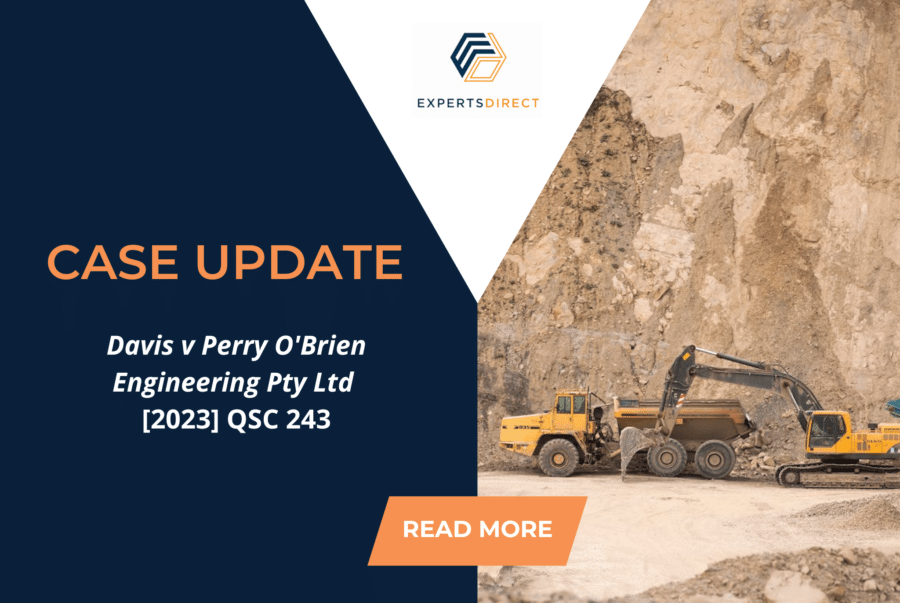Davis v Perry O’Brien Engineering Pty Ltd [2023] QSC 243
In this case, the methodology employed by a valuation expert, together with his personal friendship with one of the parties, was cause for concern for the court.
Background
The plaintiffs (the Sellers) owned an earthmoving and civil contracting business. In October 2015, the Sellers entered into a Share Sale Agreement (SSA) with the defendants (the Buyers).
Prior to settlement of the SSA, the defendants discovered that there were undisclosed liabilities of the company. The parties negotiated amendments to the sale arrangements, and the SSA was completed in December 2015. In February 2016, the Buyers realised that the business was in very a very poor financial state, and refused to pay further amounts owing under the SSA.
The Sellers commenced proceedings for various sums they claimed were owned to them under the amended SSA.
The Buyers argued that if even if they had not been misled by the Sellers and had been given an accurate financial picture of the business, they would not have proceeded with the SSA.
The Buyers counter-claimed for damages being the difference between what they paid under the SSA and the value of the shares (which was principally the net value of the plant and equipment at the date of settlement in December 2015).
The Sellers argued that the amount the Buyers might recover should be reduced under s 137B of the Competition and Consumer Act 2010 (Cth) (the CCA) on account of the defendants’ “failure to take reasonable care” within the meaning of that section.
Expert evidence
Expert reports were obtained by the parties from forensic accounting experts: Mr B for the Sellers and Ms O for the Buyers.
Ms O was instructed to adopt a plant and equipment value of $2,770,157 based upon the Auction Realisable Value provided by a valuer. On the other hand, Mr B was instructed to adopt a fair market value of $4,602,000 for the company’s plant and equipment as at 23 December 2015, based on a “Desktop Valuation” prepared by a plant and machinery valuer, Mr M.
The court identified a number of issues with the Desktop Valuation prepared by Mr M, which was later relied upon by Mr B, being:
- the limitations of his Desktop Valuation;
- his personal friendship with one of the Sellers; and
- his evidence as to the condition of the equipment, and risk of loss of one of the Sellers’ clients.
The court held that Mr M’s valuation and oral evidence had the following limitations:
- His report was a desktop valuation based on information and other materials provided by the Sellers’ solicitors.
- He did not sight nor inspect the equipment.
- He did not make inquiries of those who were familiar with the condition of the equipment. [360]
- The figures he adopted included advertised sale prices, not actual sale prices. [361]
Further, it was revealed under cross-examination as well as in Facebook posts, that Mr M had a personal friendship with one of the Sellers. While Mr M’s report stated that he was independent of the parties and their legal representatives (which presumably meant that he had no financial interest in the transaction), Applegarth J found his personal friendship with one of the Sellers undermined the value and reliability of his evidence as an independent expert. The Court held that some unconscious bias may have existed in Mr M’s approach but did not suggest that he had deliberately overstated the value of the equipment. [362]
The other major issues found by the court in Mr M’s report were:
- The indication that he assessed the plant and equipment on the basis that the majority were of “average to good condition for their age”. However, this assumption was not borne out by the evidence as the service records suggested that certain equipment had not been properly maintained. [363]
- There was a risk that a loss of a client of the Seller would result in offloading of equipment, which meant some equipment would not fetch a fair market price. The risk undermined the fair market value Mr M attributed to the equipment devoted to that contract. [366]
The court found that the figure of $4,602,000 adopted by Mr M was not supported by the evidence, and that he had substantially overstated the true value of the equipment. [367]
As a result, Mr M’s figure was substantially discounted by the court. After reasonable determination, it was ruled that the value of the plant and equipment as at 23 December 2015 was $3,700,000. [370]
In conclusion, the court held that the Buyers suffered loss and damage of $1,646,798 by misleading conduct in contravention of the CCA and by the plaintiffs’ breach of contract.
Key takeaways
- Experts should undertake all necessary research, inquiries and inspections (where relevant) to ensure that the conclusions drawn in their report are based on sound reasoning.
- Where an expert has a pre-existing relationship with their instructing party, the upfront disclosure of that relationship may be preferrable to it coming to light during cross-examination of the expert.
- Assumptions given to the expert must be borne out by the evidence adduced in the case. Issues with assumptions may affect the weight or admissibility of the expert’s evidence.
Read the full decision here.
